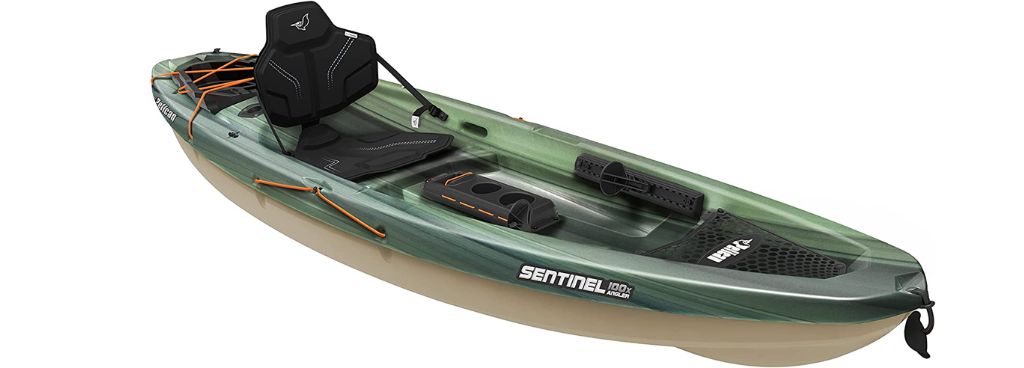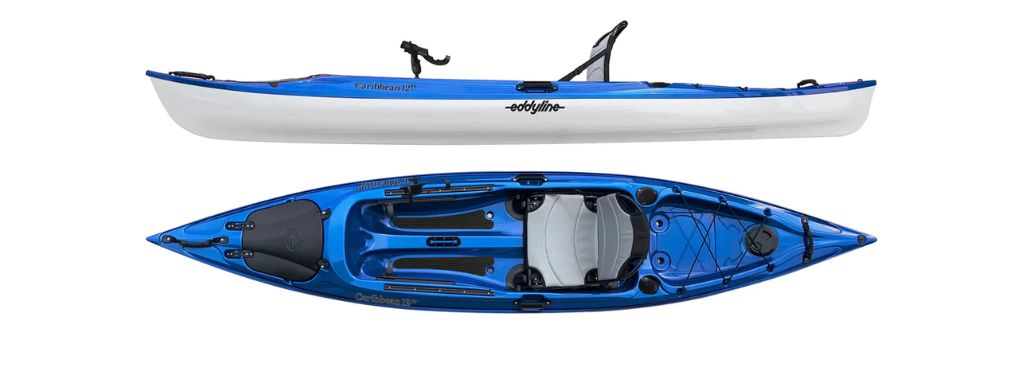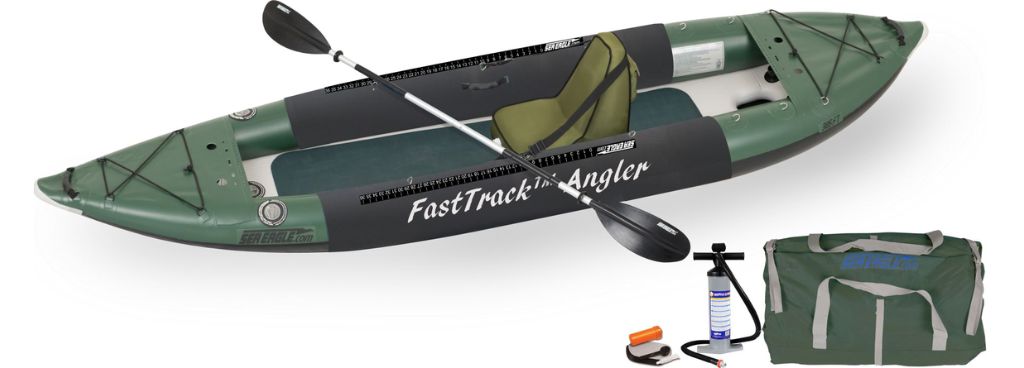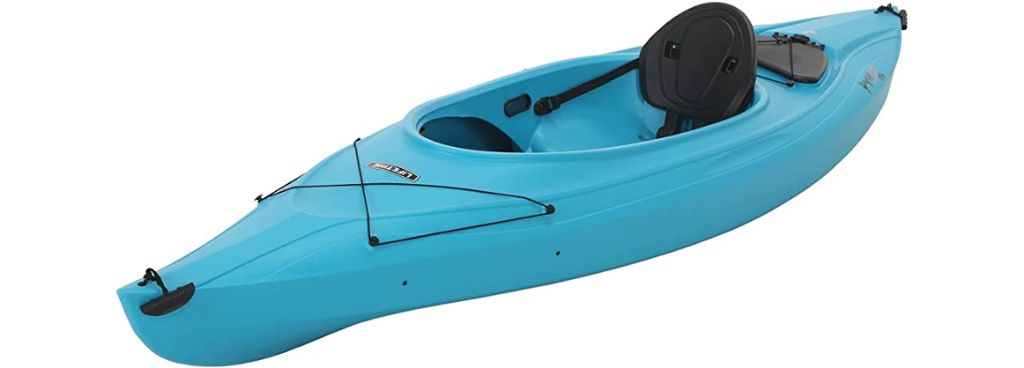Stories Worth Reeling In...
Last Updated on September 21, 2023
Whether you’re a seasoned angler looking for an upgrade or a newbie setting out on your first fishing trip, a lightweight kayak can be a game changer. Many anglers can attest from personal experiences that these kayaks simplify transportation and storage and provide superior maneuverability and speed, allowing you to reach your favorite fishing places easily.
Table of Contents
Here’s a look at some of the top lightweight fishing kayaks. Continue reading for in-depth reviews, which include practical buying tips to assist you in making the best decision for your needs.

I’m always dubious when I come across cheap fishing kayaks because it raises questions about their quality and performance. However, Pelican Kayaks has a long history of producing dependable kayaks, and the Pelican Sentinel 100X Angler is no exception.
For those who wish to spend time on the lake without breaking the bank, the kayak provides a steady and trustworthy fishing experience.
One part of this low-cost fishing kayak that pleasantly pleased me was its assortment of bespoke features. The middle console between your legs has various slots for tiny needs like spare gear and line. The kayak also includes two vertical rod holders, two flush-mounted holders, accessory eyelets, and a paddle tie-down, allowing you to tailor the Sentinel to your needs.

The Eddyline Caribbean 12FS Angler is an excellent choice for warm-weather day trips since it has all the required equipment and gear for a stress-free fishing session. Unlike most sit-on-top fishing kayaks, which can feel hefty and bulky, the 12FS weighs only 45 pounds, making it much easier to handle and transport.
You may easily find a comfortable posture with its well-padded and adjustable design, regardless of your body shape. Furthermore, the removable seat is a handy camp chair for those memorable evenings recounting the day’s events.
The big stern hatch is open-air but has bungee cords to secure bulkier items like a cooler or tackle box. A smaller, waterproof hatch in the bow keeps your delicate belongings dry.

Its inflatable design ensures stability and durability, and its compatibility with a modest electric motor makes it extremely adaptable.
It can support a 15-pound motor, allowing me to go to my favorite fishing places swiftly and easily. When I got there, the wide 36-inch hull and non-slip surface provided a sturdy platform for standing and casting, even in windy or wavy circumstances.
The sprayskirts include built-in rods, hooks, lure holders, and additional storage behind bungee cords. With minimal care, the inflatable material is robust, rigid, and resistant to punctures and serious damage, and filling the kayak was simple and intuitive, taking less than ten minutes after I got the hang of it.

Despite its thinner shape, the Perception Sound 10.5 is a superb sit-in choice that brings you closer to the water and provides stability.
Although this large open-air compartment features bungee cords for fastening items, it limits what you may carry. Shorter paddlers, I discovered, could put some gear in front of their feet, but organization and accessibility can be difficult. On the other hand, a small dashboard in front of the cockpit is ideal for storing small goods.
The kayak has two accessory mounting points and two molded rod holders, offering you some customizing choices.

With its sporty, compact design that performs well on calm waters, this kayak is best suited for casual kayak fishermen or beginners.
While the Payette Angler 98 lacks personalized features such as gear tracks and accessory eyelets available in more expensive kayaks, it offers remarkable stability and handling for paddlers of all skill levels.
Although storage is restricted, Lifetime has used the shorter keel well. The bow has bungee cords easily accessible from the cockpit, while the stern has a designated storage compartment for critical materials.
Despite its slimmer shape, the kayak is stable, and the seatback is well-padded. However, adding more cushioning to the seat bottom made it more comfortable.
Sit-in fishing kayaks are more sleek and classic in appearance. The seat is situated below or at the waterline on the hull, and the top of the bow encases your legs and hips, providing further protection from the elements, especially when a spray skirt surrounds the cockpit. On the other hand, sit-on-top kayaks have a cockpit placed higher above the water, allowing more legroom and making seat adjustments easier while on the water. These kayaks must be broader to compensate for the greater center of gravity because the seat is higher.
Aside from those two models, I’ve discovered that the Eddyline Caribbean 12FS/14FS and Perception Sound 10.5 are very good at tracking, owing to their long keels. This ability is handy when paddling in windy places where you can get blown off course.
Good stability and tracking are essential for a satisfying and successful day of kayak fishing, so choose your lightweight fishing kayak with consideration.
Hard-shell kayaks with plastic hulls last a long time and require little maintenance. As a result, these kayaks may be landed safely on most beaches. However, I’d be cautious while landing on rocky beaches, especially in big surf.
Inflatable kayaks, on the other hand, necessitate a little more attention. Despite their reputation, I’ve discovered they are surprisingly tough and can easily withstand most ordinary knocks or on-water crashes. However, I would advise being extra cautious while landing on beaches and dragging them over anything other than sand.
While these kayaks are easy to transport and carry, the Hobie iTrek 9 takes the cake regarding portability. With a fully rigged weight of about 37 pounds and a kayak weight of only 20 pounds, carrying it to remote lakes or rivers is a breeze, even on hiking trips or airplane travels.
Moving your kayak from the parking lot to the water may be difficult for a lone fisherman. In that scenario, I propose buying in a kayak cart to simplify the process.
Most hard-shell kayaks in this category are constructed of durable, rigid polyethylene plastic. Many manufacturers and kayakers prefer this plastic because it is cost-effective and low-maintenance.
Inflatable fishing kayaks, on the other hand, have a somewhat unjustified bad image due to the market’s prevalence of inferior designs.
Your material selection will be influenced by aspects such as your budget, transportation, and storage possibilities. However, if you get a high-quality kayak, you can anticipate durability and dependable performance from both hard-shell and inflatable kayaks.
Lightweight kayaks are often shorter, and because a kayak’s speed is proportional to the length of its keel, none of the kayaks we’ve studied will establish any speed records.
Small fishing kayaks may not be as fast as larger versions, but their maneuverability is frequently superior. Hobie iTrek 9 and Pelican Sentinel 100X designs thrive at making fast turns and squeezing into small areas that larger boats cannot access.
The greater mobility of these smaller vessels gives a more user-friendly experience for individuals just getting started in kayaking. As you practice and perfect your paddling skills, this increased margin for mistakes may be a wonderful confidence booster.
The value of comfort during those long days on the water cannot be overstated. Even the most feature-rich kayak will not serve you well if it causes back pain or numbness in your legs.
Many new kayaks, thankfully, include ergonomic, adjustable, and well-padded seats. of hot summer days, the breathable mesh back coverings of these seats make a world of difference in keeping me cool and comfortable.
Sit-in kayaks on this list may be too small for large and tall kayakers. It’s not a problem in the design but rather a byproduct of making the kayaks small and lightweight.
The last thing you want is a tippy kayak that threatens to capsize as you try to reel in that big fish.
Secondary stability is often better in sit-in kayaks. So, while they may appear shaky, they can actually rock back and forth quite a little without tipping over. This sensation can be unsettling for individuals new to paddling, so I recommend starting near the shore until you feel comfortable.
Sit-on-top kayaks, on the other hand, have better primary stability, giving you a steadier feel with less swaying. However, if you begin to tip, you can do little to avoid a full capsize.
Good stability and tracking are essential for a satisfying and successful day of kayak fishing, so choose your lightweight fishing kayak with consideration.
Lightweight fishing kayaks have both advantages and disadvantages. Their portability makes them easy to transport and carry, and their shorter keels provide outstanding maneuverability. They can be wonderful solutions if you’re ready to accept their lower load capacity and restricted storage space.
Finally, the finest lightweight fishing kayak depends on your needs and preferences. Still, these two models stand out and can substantially improve your angling excursions.